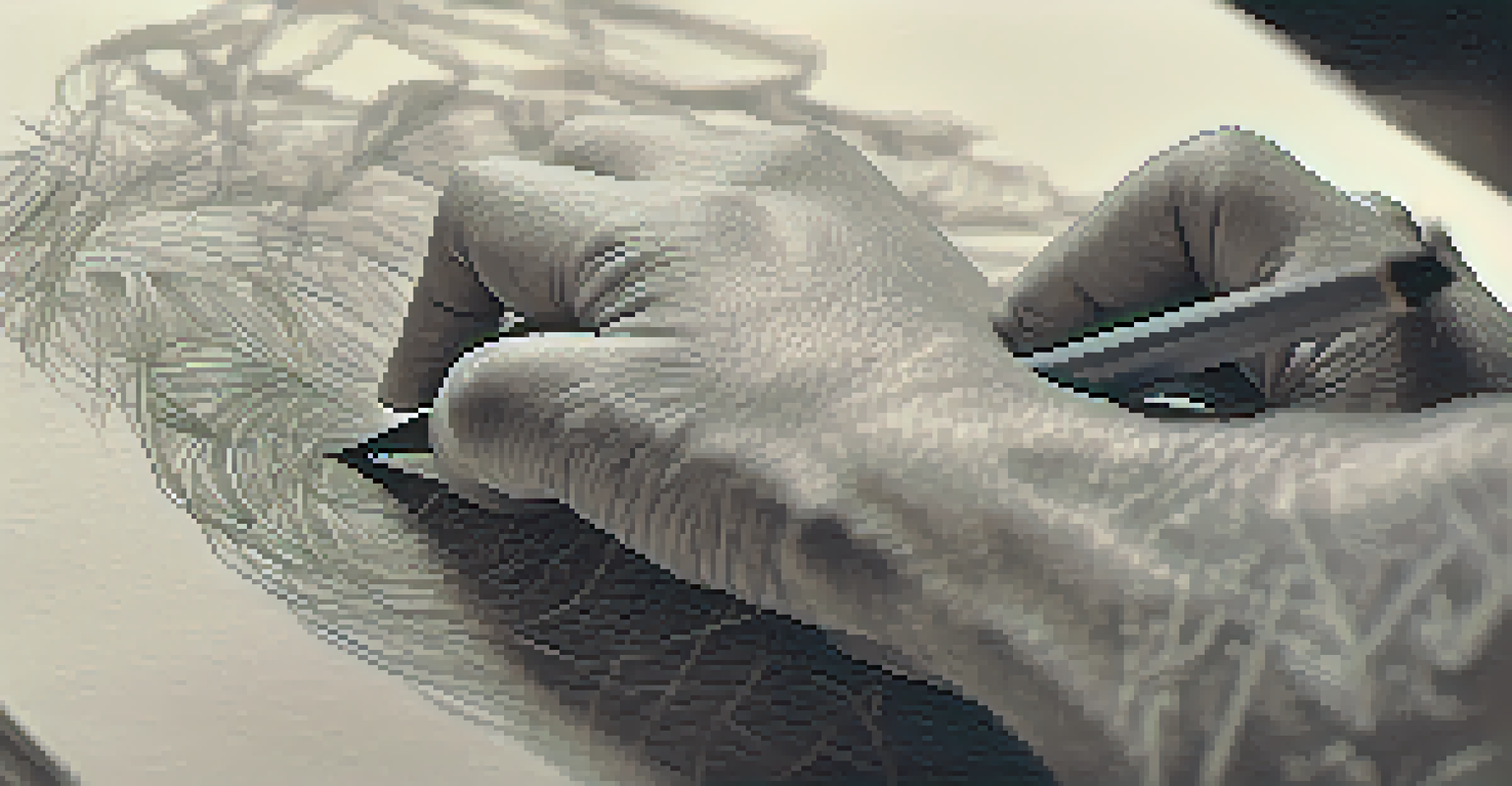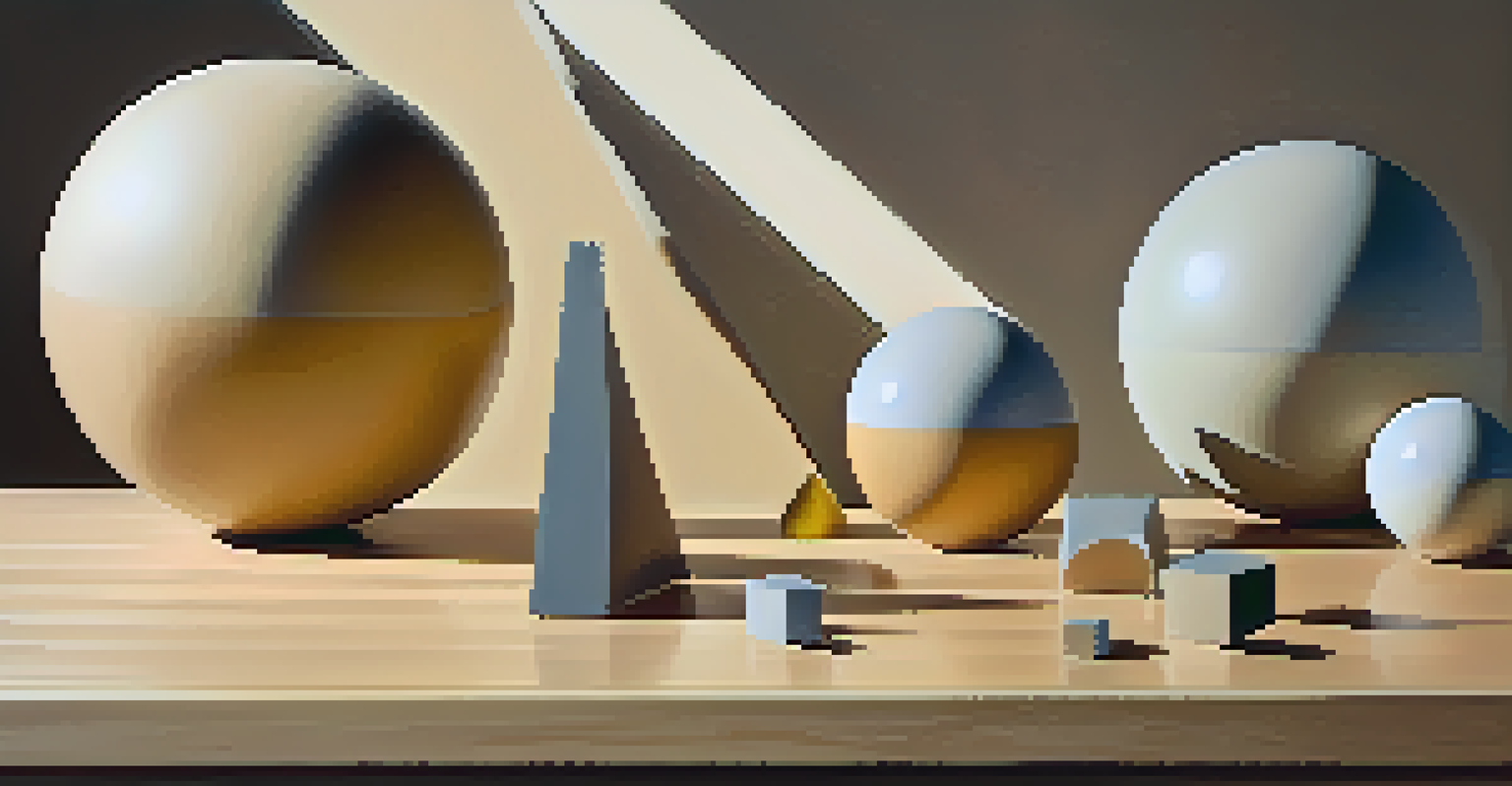The Fundamentals of Figure Drawing: Techniques for Artists

Understanding the Human Form: A Fundamental Approach
At the heart of figure drawing lies the human form, a complex structure that artists seek to capture. Understanding its anatomy is crucial, as it informs how we depict movement and emotion. Start by studying the proportions of the body; for instance, the average adult is about 7.5 heads tall, which helps establish a baseline for your sketches.
Drawing is not what one sees but what one can make others see.
Once you grasp these proportions, consider the skeletal and muscular systems. Familiarizing yourself with the major bones and muscle groups can significantly improve your understanding of how the body moves. This knowledge allows you to create more dynamic and realistic poses.
Remember, drawing from reference is invaluable. Whether it’s photographs or live models, observing real human figures will deepen your insight and enhance your skills. Practice sketching various body types and postures to broaden your artistic range.
Gesture Drawing: Capturing Movement and Emotion
Gesture drawing is a technique that focuses on quickly capturing the essence of a pose, prioritizing movement over detail. This method encourages you to observe the flow and energy of a figure rather than getting bogged down by intricate details. A typical session might last anywhere from 30 seconds to a few minutes, challenging you to work swiftly.

To get started, use a light hand and focus on the overall shape of the figure. Think of each pose as a series of curves and lines that express motion. For example, a dancer in mid-leap can be represented with sweeping lines that convey grace and dynamism.
Master Human Anatomy for Art
Understanding human anatomy and proportions is essential for creating realistic figure drawings.
Regular practice in gesture drawing can significantly improve your ability to depict life and movement in your art. It’s not about perfection; instead, aim to create a sense of vitality that makes your drawings come alive.
Constructing the Figure: Basic Shapes and Forms
When drawing the human figure, breaking it down into basic shapes can simplify the process. Start with simple geometric forms like spheres, cubes, and cylinders to represent different body parts. For instance, the torso can be visualized as an elongated cylinder, while the head can be represented as a sphere.
The more I draw, the more I want to learn about drawing.
This method not only aids in understanding proportions but also helps in visualizing the figure in three dimensions. By focusing on these basic shapes, you can build a solid foundation that allows you to add detail and refine your drawings later.
As you become more comfortable, experiment with manipulating these shapes to create various poses. This approach encourages creativity and helps you develop your unique style while maintaining a strong structural foundation.
Light and Shadow: Adding Depth to Your Drawings
Light and shadow play a vital role in figure drawing, as they add depth and dimension to your artwork. Understanding how light interacts with the human form can transform flat sketches into lifelike representations. Start by identifying your light source; this will guide where highlights and shadows fall on the body.
When applying shading, consider the planes of the body. For instance, areas like the chest and thighs will reflect light differently than the inner arms or behind the knees. Using a range of values, from dark to light, will help create a three-dimensional effect.
Practice Gesture Drawing Regularly
Gesture drawing helps capture movement and emotion quickly, enhancing your ability to depict life in your art.
Practice observing how light affects your subjects in real life. Whether drawing from a model or a photograph, always pay attention to how shadows create form and movement, allowing your figures to pop off the page.
Proportions and Anatomy: The Key to Realistic Figures
Proportions are essential for achieving realism in figure drawing. Familiarizing yourself with the standard proportions of the human body—like the head-to-body ratio—can help you create more accurate representations. For instance, knowing that the arms typically reach down to mid-thigh can guide your sketches.
Incorporate anatomical knowledge into your practice to understand how muscles and bones influence the figure's appearance. This insight is key for artists aiming to convey realistic movement and expression in their work.
Using reference materials, such as anatomy books or online resources, can deepen your understanding. This knowledge not only enhances your drawings but also boosts your confidence as you explore more complex poses and expressions.
The Importance of Practice: Building Your Skills
Like any skill, figure drawing requires consistent practice to improve. Set aside dedicated time each week to draw, focusing on different techniques and aspects of the human figure. The more you practice, the more your eye will develop, allowing you to notice subtle details and proportions.
Consider joining figure drawing classes or workshops to gain valuable feedback from instructors and peers. These environments can provide motivation and help you push your boundaries, making your practice more effective.
Explore Personal Artistic Style
Incorporating your unique style into figure drawing allows your work to stand out and evolve as you grow as an artist.
Remember, it’s not just about quantity; quality matters too. Spend time on each drawing, analyzing what works and what doesn’t. Over time, you’ll see significant improvement in your ability to draw the human form.
Incorporating Style: Making Figure Drawing Your Own
While mastering the fundamentals is crucial, integrating your personal style into figure drawing can make your work stand out. Explore different mediums, such as charcoal, ink, or digital tools, to discover what resonates with you. Each medium offers unique possibilities for expression and can influence the overall feel of your artwork.
Experiment with various techniques, such as exaggeration or abstraction, to develop a distinctive voice in your figure drawings. This can involve emphasizing certain features or playing with proportions for artistic effect.

Ultimately, embrace the journey of finding your style. It’s a personal exploration that will evolve as you grow as an artist, blending technical skill with your unique perspective.
Resources for Further Learning: Expanding Your Knowledge
To continue improving your figure drawing skills, seek out resources that inspire and educate. Books on anatomy and figure drawing techniques can provide in-depth insights, while online tutorials offer flexibility for learning at your own pace. Websites like Skillshare or YouTube are treasure troves of instructional videos from experienced artists.
Consider following figure drawing blogs or joining online communities where you can share your work and receive constructive feedback. Engaging with fellow artists can provide fresh perspectives and motivate you to keep practicing.
Lastly, don’t forget to visit museums or galleries to study the works of master artists. Observing how they approached figure drawing can spark ideas and deepen your appreciation for the art form. Every resource you explore contributes to your growth as an artist.